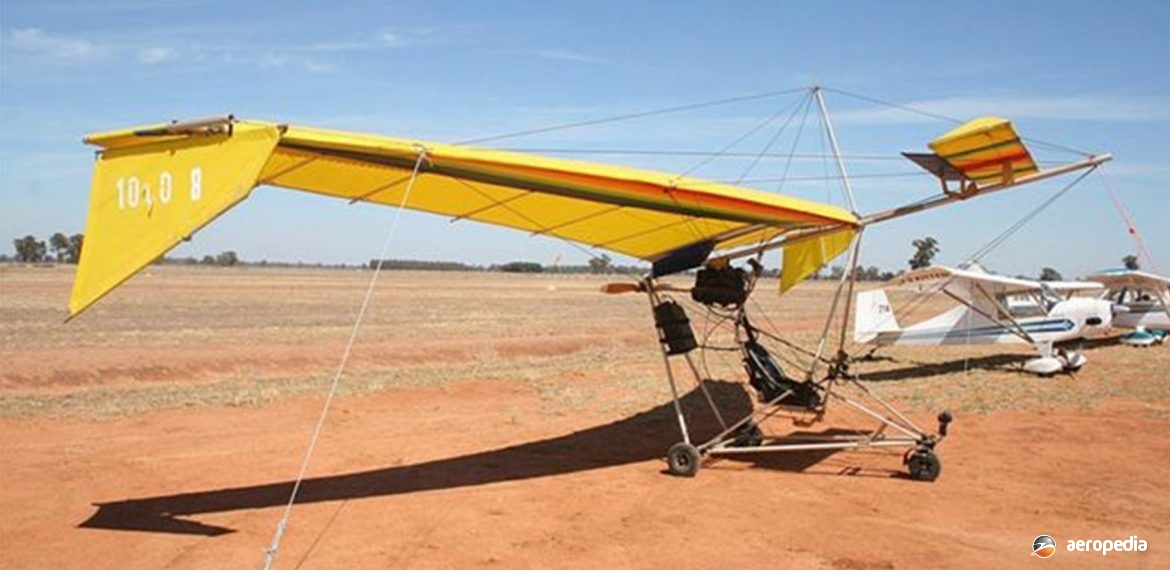Photograph:
Those Flying Machines Pegasus Supra 10-0008 (c/n not known) (The Aussie Aviator.net)
Country of origin:
United States of America
Description:
[Pegasus I] Single-seat single-engine high-wing aircraft
[Pegasus II] Two-seat single-engine high-wing aircraft
[Pegasus Supra] Single-seat single-engine high-wing aircraft
Power Plant:
One 26 kw (35 hp) at 5,800 rpm Cuyuna 430 two-cylinder fan-cooled engine
Specifications:
- Wingspan: 9.8 m (32 ft 1 in)
- Length overall: 14.7 m (15 ft 4 in)
- Height: 3.0 m (9 ft 9 in)
- Wing area: 16.9 m² (182 sq ft)
- Never exceed speed: 88 km/h (55 mph)
- Max speed: 97 km/h (60 mph)
- Cruising speed: 59 km/h (37 mph)
- Stalling speed: 40 km/h (25 mph)
- Fuel capacity: 15.9 litres (3.5 imp gals)
- Max rate of climb at sea level: 137 m/min (450 ft/min)
- Empty weight: 92 kg (203 lb)
- Loaded weight: 228 kg (503 lb)
History:
The Pegasus was a single-engine high-wing monoplane with hybrid control, the wing having a swept back leading-edge and a tapering chord. It had a canard wing and no tail. Pitch control was by elevator on the canard with yaw control by wing-tip rudders, there being no separate roll control. The pilot sat in a swing seat connected to the elevator on the canard and a tiller arrangement, which was sometimes called a yoke, operated the rudders.
It initially came in two models, the single-seat model known as the Pegasus I with a Cuyuna 202 engine, and the two-seat model known as the Pegasus II with a Cuyuna 430 engine, which was a two-cylinder snowmobile engine re-designed as an ultralight aircraft engine, but a Kawasaki unit could also be fitted, this having an electric start. For the Pegasus I the more powerful 15 kw (20 hp) Cuyuna 215 [215 cc] unit could also be installed. Options included hand and ballistically deployed parachutes and a strobe light. The Pegasus II was produced in ready-to-fly form from 1983.
Both models being a hybrid control machine, control inputs through weight-shift were available for pitch and tiller for yaw. The wing was braced from above by kingpost and cables, and from below by cables. No brakes were fitted and the framework was built of aluminium. A few examples were imported to Australia in the 1980s.
The Pegasus Supra was one of a range of ultralight aircraft produced in the 1980s by Those Flying Machines Co in California. Whereas the Pegasus I and Pegasus II had a suspended swing seat for weight shift purposes the Pegasus Supra had a fixed seat. It had swept back leading and trailing edges and a tapered chord. There was no tail and it had a canard wing that controlled the pitch and yaw by tip rudders. Roll control was by spoilerons. Control inputs were via a stick for pitch and roll, and pedals. It had no brakes but had nosewheel steering.
Specifications for the Pegasus Supra: max speed 102 km/h (63 mph); cruising speed 72 km/h (45 mph); stalling speed 43 km/h (26 mph); rate of climb 268 m/min (880 ft/min); and range 202 km (125 miles).
Examples known to be imported to Australia were 10-0008 registered on 27 February 1987 in Victoria, cancelled on 25 October 2015; and 19-8602 registered on 5 March 2015 in Tasmania. One is on display at the Holbrook, NSW Ultralight Museum.

